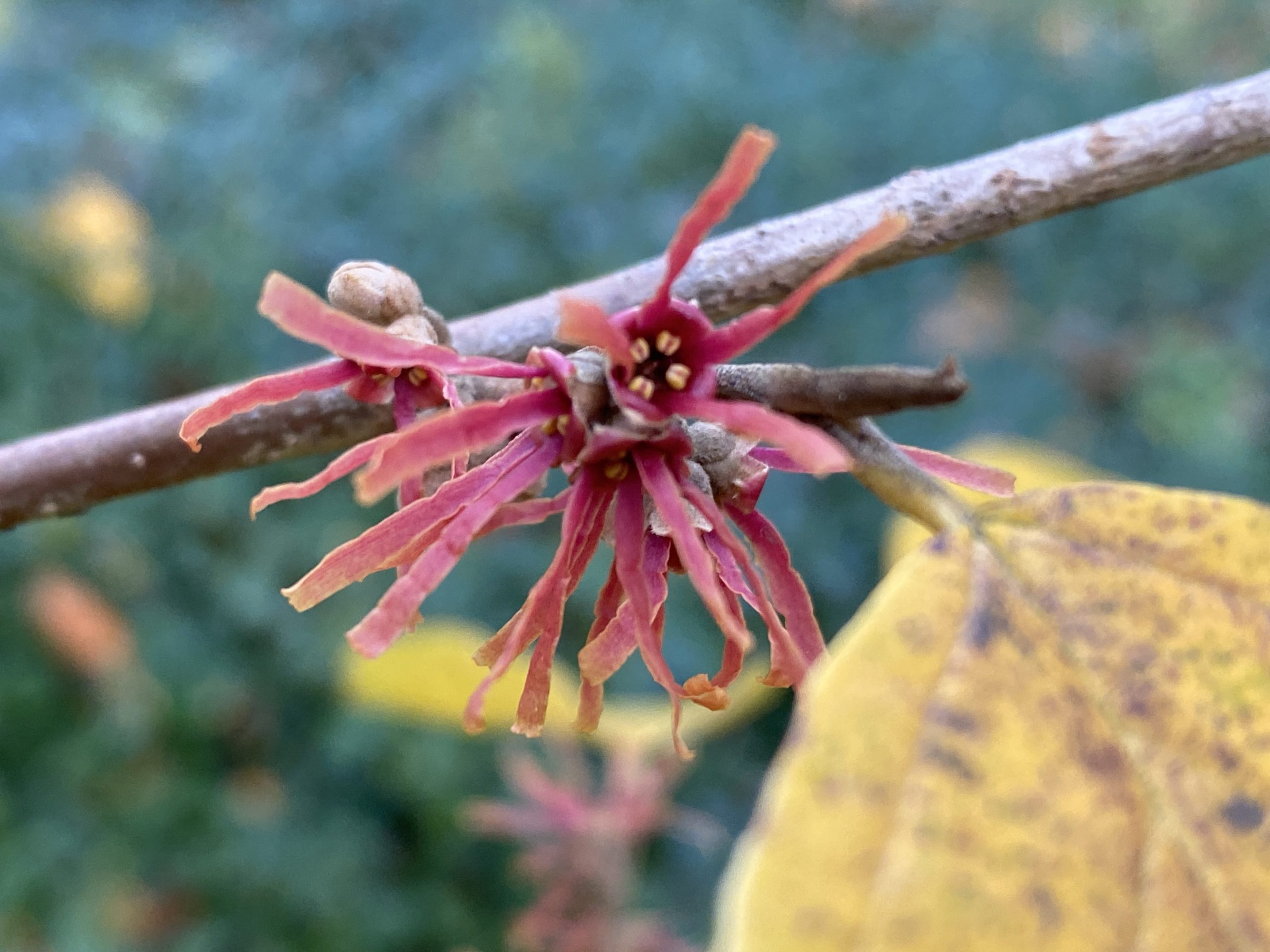
At LongHouse Reserve in East Hampton, the most unexpected sight lies in its winter garden — lit up by fragile, freshly unrolled spidery flowers of pale yellows, oranges, ruby reds and occasional purples.
A guided walk through the witch hazel collection, which I lead starting in early March, is a welcome break from the winter doldrums — the person-tall shrubs covered in blooms at the most unimaginable time, next to little winter-blooming bulbs on the ground, that are almost mythical by comparison.
A brief step back in time to late fall finds the native Hamamelis virginiana, known as common witch hazel, holding its pale yellow blooms until just before Christmas, sometimes draped in a blanket of snow; a particularly beautiful form is “Harvest Moon.” By the end of December, early forms of Ozark witch hazel, or Hamamelis vernalis, are blooming, with its smaller and somewhat less significant flowers.
If you prefer showier blossoms, look for early blooming hybrids — which, for many of us, are our introduction to witch hazel. Looking back almost 50 years ago, my own first encounter was the beautiful and sweetly scented palest yellow “Pallida.” It still shines from afar through the woods in my memories, just as it does at present.
For many years, “Jelena” has been a welcome stop at the back entrance of the Brooklyn Botanic Garden during my annual pilgrimage in February. Out east, it takes “Jelena” often a month longer before it unfurls its bright orange flowers. Most gardeners probably have found that “Arnold’s Promise” is their first encounter with witch hazel, because it was available at garden centers, whereas “Dianne” — with its bright red flowers — is more difficult to acquire.
“Beholden” is the earliest for us in the new year, with red blooms that fade to orange, sometimes with the fall-tinted golden leaves intact at the early part of its flower display, followed by “Girard’s Purple” in mid-January. And even with the entire color palette covered already, we still continue to add more witch hazel cultivars — there are now over 300 registered forms — every year to our growing collection, and there are multiple reasons for this.
Because many cultivars do not flower at exactly the same time, we can extend the blooming time of each color in the yard, and each witch hazel cultivar performs quite differently from year to year, so there is a better chance to have a champion every winter, in your collection.
Also, the general performance and disease resistance has improved with some newer cultivars. Take old “Arnold Promise,” for example, which for years was praised as one of the best performers. Unfortunately, on the northern reaches of the East Coast, it gets a leaf-wilt in early spring and we’ve even considered removing it from our plantings at LongHouse to keep the other cultivars healthy.
Gardeners have been waiting for ages to finally have access to more varieties at local nurseries and garden centers. In most cases, you still need to resort to mail order, but you can see newer and lesser-known varieties that we grow and observe at LongHouse, which you can also plant in your garden.
“Gingerbread” and “Orange Peel” are both desirable, orange-colored, early blooming forms — the former grows broad and not too tall, while the latter grows more in a shape of a Virginia cedar. “Rubin” is our best and most consistent bright red performer, whereas other red cultivars disappoint in some years when they display more orange.
“Birgit” is the darkest purplish red with an amazing display, in some years, that convinces us to keep it, but in other years, it performs just so-so. “Harlow Carr,” on the other hand, puts on a wonderful, golden, clear yellow display and is a prolific bloomer, with tight clusters of flowering buds.
“Aphrodite” is a good orange red, “Zitronenjette” is a more compact pale yellow form, which blooms rather late, and “Barmstead Gold” has performed well for years — and it just gets better with age. “Aurora” has become well-established and even though the flower color is a bit muddled, it makes quite a show.
“Sweet Sunshine” is a newer, good performer with plenty of medium-sized golden yellow flowers, and “Wisley Supreme” is certainly beautiful with its bright yellow flowers, but it can catch the previously mentioned leaf disease if you have “Arnold Promise” nearby. Planted by itself, it would probably do just fine. After all, it received the highest award from the Royal Horticultural Society.
Before choosing a specific cultivar, consider where you want to plant it. A dark background contrasts with the lighter yellows better than reds or deep oranges. You might not want to plant an orange variety in front of a hornbeam hedge, because it would blend right in, whereas red or pale yellow would stand out much better.
Consider a spot in the garden that is not too dark, otherwise your plant will just grow like bean sprouts to reach more light and develop very few flowers in the process. The lightest shade — preferably partial shade — would suit your new addition best. And keep in mind that an established witch hazel will, on average, grow 8 to 12 feet tall with an 8-foot diameter.
Witch hazels can be correctively pruned by removing competing branches selectively, but they are not as forgiving as forsythias and less pruning reveals their natural beauty. And, beware, rabbits might attack newly planted smaller twigs, but a little rabbit fence will give protection and is only needed for the first year.